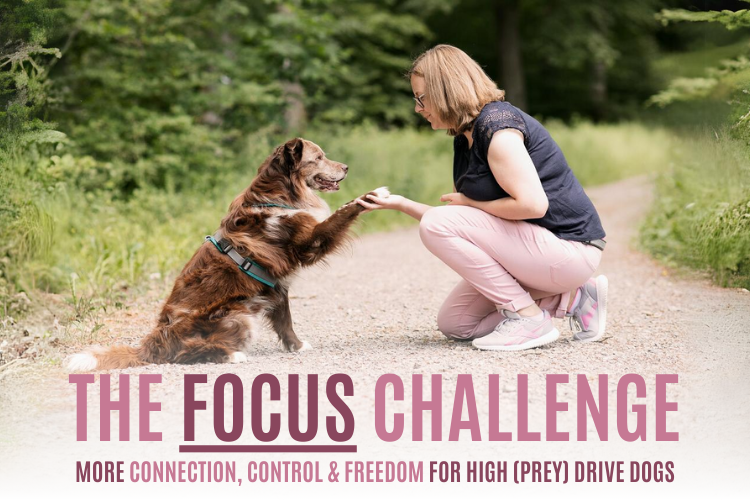Whether it’s chasing a squirrel at the blink of an eye or jumping into action without a second thought, managing a dog’s natural impulsiveness requires understanding and strategic training. This blog post delves into the nature of impulsivity in dogs, the critical role of impulse control, and practical strategies to enhance it. That’s why I wrote this post for you!
Join me as we uncoversome details about your dog’s impulsivity and how you can channel it into positive outcomes, fostering a deeper connection between you and your dog.

What is Impulsivity in dogs?
Some dog breeds have been selectively bred to have high levels of impulsivity. This means they are able to spring into action almost instantaneously, which benefits their human in some way. A classic example of this is seen in hunting breeds. For example, a Hound doesn’t think twice about following a wildlife scent, as soon as they detect one, they begin to track it. Or, a Spaniel doesn’t wonder if they should flush wildlife from the undergrowth, they immediately go and do so. This impulsivity is highly desirable in working and hunting breeds, but it can quickly cause tension and strain for owners of pet dogs who are naturally impulsive.
Impulse Control: A Game Changer (your dog can learn)
Impulse control is defined as the ability to consciously control and direct your own emotions and actions, and the same applies to our dogs too. In reality, it means your dog holds themself back from doing something they really want to do, in return for doing something you ask them to do instead. This could be them not chasing a squirrel that runs past them, and doing tricks with you instead.
However, whenever your dog needs to demonstrate solid impulse control, this takes a great deal of mental energy. Impulse control is limited resource, and when it is all used up, frustration and stress quickly kick in.
During times of high stress, fear aggression and predatory behaviour are triggered much more quickly, which makes it more challenging for your dog to consciously inhibit instinctual behaviour with learned behaviour. This can cause roadblocks in your training journey.
A great way to start teaching your dog how to show impulse control is to join us for ‘The Focus Challenge – 15 Days to Achieve More Connection, Control & Freedom With Your High (Prey) Drive Dog’. Click HERE to find out more!
What Impacts Impulsivity And Impulse Control?
Younger dogs can find it more difficult to control their impulsivity, because they are still learning how to process and respond to their natural urges and have likely had little training around impulse control. A dog’s age, health, diet, and whether they are feeling well mentally and physically can all affect their ability to show impulse control.
Bigger, heavier dog breeds, with denser bones tend to have better impulse control. This may be because they are less likely to be bred specifically for impulsiveness, and because they are physically not able to react as quickly as leaner, lighter breeds.
Impulse control can only be learned and applied to specific circumstances which makes it difficult to generalise this learning in the same way that other learned behaviours would be effectively scaffolded and applied to different scenarios.
It’s not possible for dogs to show starkly different behaviours at the same time as each other, so one behavour has to end, in order for them to show another. So, an example would be the dog’s instinctual behaviour to chase after a deer, for them to stand and watch the deer without chasing would be a learned behaviour and this costs them a lot of impulse control!

How Can We ‘Save’ Impulse Control?
Traditional exercises to encourage impulse control can actually be counterproductive for dogs who are easily over-aroused and naturally impulsive. These exercises tend to encourage your dog to sit or lie down, and wait, while something exciting is going on around them. Once they do this successfully, they are released from this position, to take part in whatever it is they were watching. However, this quickly builds frustration, and can use up all of their impulse control very quickly, which doesn’t set them up for success.
Instead, you can teach your dog games where we don’t actually tell them to wait, but we create an environment where they actively want to stay close to us and work with us. This means it doesn’t feel like traditional waiting, for your dog, which uses up less impulse control than them having to physically stay still in one place for prolonged periods.
Sign up for my newsletter and keep your eye open for the next article, where I will give you lots of practical examples of how you can save your dog’s impulse control throughout the day. This will mean when they are in situations where they really need to use some impulse control, they will still have plenty left to use up, instead of approaching it with an ‘empty tank.’
How to train your dogs Impulse control?
Navigating the lively spirit of a high-energy dog can be both exhilarating and exhausting. Learning how to train your dog’s impulse control and shaping impulsive tendencies into positive behaviours isn’t just about teaching commands—it’s about enhancing your connection and enriching your lives together.
If you’re looking for support in this journey, consider joining our ‘Focus Challenge; 15 Days to Achieve More Connection, Control & Freedom With Your High (Prey) Drive Dog’. It’s a step toward deeper understanding and more joyful moments with your furry companion. I’m here to help you build that bridge. Click HERE to learn more and take the first step together.
About me
Hey there, I’m Simone Mueller, and I’m a certified dog trainer and behaviour consultant (ATN.AG) based in Germany. I’m passionate about helping dogs and their guardians around the world through force-free anti-predation training. That’s why I founded “Predation Substitute Training™ (PST)”, a unique and effective program that stops uncontrolled predatory chasing and provides safe outlets for your dog’s natural drive. In my blog articles, I’d love to share my knowledge and experience with you and help you and your furry friend live a happier and safer life together!

